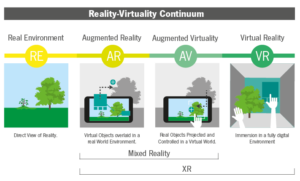An overview
Until recently, merging the real world with the virtual world has been the subject of science fiction and advanced research, but nothing that normal citizens would experience in everyday life. This could soon change with the advent of Extended Reality, also known under its abbreviation XR.
XR is an umbrella term for immersive technologies including augmented reality (AR), augmented virtuality (AV), virtual reality (VR), and mixed reality (MR), which can be any combination of AR, AV, and VR.
The XR concept is rooted in the reality–virtuality continuum, which is a continuous scale ranging from the completely real, what we call ‘reality’, to the completely virtual, also called ‘virtuality’. The reality–virtuality continuum encompasses all possible variations and compositions of real and virtual objects. The concept was first introduced by Canadian professor Paul Milgram and Japanese professor Fumio Kishino in 1994.

The reality-virtuality continuum
The metaverse hype
A term closely related to XR is ‘metaverse’, which was coined by Neal Stephenson in his 1992 science fiction novel Snow Crash. According to Wikipedia, “a metaverse is a network of 3D virtual worlds focused on social connection”. In 2021, the metaverse became one of the most hyped concepts in the tech world, while most people still did not know, what it really is. The reason for the hype was the new vision proclaimed by Facebook CEO Mark Zuckerberg when he explained a set of new initiatives and the renaming of his company to Meta Platforms: “Our overarching goal across all of these initiatives is to help bring the metaverse to life.” [1]
Despite the buzz around the fuzzy concept of the metaverse, there are nonetheless hard facts behind it, if we look at XR as the technological foundation for whatever the metaverse is going to be. Or in other words: there is a strong business case for XR.
Fast-growing XR market
According to a forecast by MarketsandMarkets [2], the XR market is expected to grow by 380 percent from USD 33.0 billion in 2021 to USD 125.2 billion in 2026. The main industries driving this expected growth are, according to the MarketsandMarkets report, the education sector, the automotive industry, the healthcare sector, and the entertainment and gaming industry. Market leaders in the fast-growing XR market are companies from the US and Asia, including Microsoft (US), Sony (Japan), Meta (US), HTC (Taiwan), and Google (US).
Europe’s position in XR
From a European perspective, this raises two major questions: 1. What share of this fast-growing market could European companies achieve? And 2. How will the spread of XR into many sectors of business and life change society?
On the first question, there are no easy answers, as it will depend on the application areas and how successful European companies will be in identifying business opportunities, exploiting available technologies and converting research results into success product and service innovations on the market. In some areas, where Europe is traditionally strong, like the automotive sector and the healthcare sector, a relatively high market share of European products and services appears possible, while it appears to be rather unlikely in relatively weak European sectors like entertainment and gaming. In addition, tight regulations on data privacy and electronic services in general could potentially limit the speed and scale for offering XR services on the European market, compared to the much more liberal market conditions in the US.
One thing is clear, though: European industry is aware of the high potential of XR and is ready to use it. A study published in 2021 by Ecorys and the XR Association (XRA) produced the following key findings: (i) Over 93% of XR companies surveyed in Europe predict growth in their sales over the next three years, with two thirds expecting their revenues to grow by more than half. (ii) The total market value of the European XR industry is expected to increase to between €35 billion and €65 billion by 2025, which would represent a gross added value of between €20 billion and €40 billion, and directly creating employment for some 440,000 to 860,000 people. (iii) Wider supply chain impacts of the XR sector, which may include a whole new ecosystem of hardware and software suppliers as well as service providers and vertical business users, are expected to indirectly increase production value to between €35 billion and €70 billion, generating an additional 780,000 to 1.5 million jobs.[3][4]
The European Commission is supporting this growth of the European XR sector through research and innovation, aiming to create a European XR ecosystem aligned with European values.[5] In this emerging ecosystem, the European Commission is encouraging cross-fertilisation between disciplines and domains, like 5G/6G, data, artificial intelligence, edge and cloud computing. The EC places “a special focus on industry and SMEs, which will support Europe to become a force in XR”.
Social impact of XR
An open question is what impact XR could have on society as a whole, and what the social implications could be. Even though XR has been around for decades, it has not yet been widely used by the majority of citizens. The impact on users and society could to some extent be compared with social media, where people spend time in virtual ways instead of physical interactions – with social and psychological effects, which have been extensively studied. In contrast to this limited commonality with social media, XR will be much more immersive and not comparable with texting and sharing of images and videos, as done in social media today.
To what extent XR will finally impact the lives of users will also depend on how well it will engage the five senses, which means going beyond sight and hearing by including also touch, smell and taste for full immersion [6]. How immersion via XR affects physiological and psychological health is the subject of ongoing research. In a recent paper, researchers from the University of Texas warn that Virtual Reality affects depression, when social connectedness and self-esteem are low [7].
While there are potential risks, XR could also contribute to improving the quality of life. If XR would develop into providing a comprehensive immersive experience, it could enable many people to enjoy experiences they could otherwise not afford, as they wouldn’t have enough time or money to get access to such experiences in the real world. Think, for example, of an immerse virtual museum visit or a concert of your favourite artist anywhere in the world. Or imagine you could attend a sports match from your sofa and experience the excitement of spectators, like you were in the stadium, without paying for an expensive ticket and being stuck in a traffic jam after the match. In this way, XR could become a significant facilitator for social inclusion.
Especially in view of the societal impacts of XR, it will be important that Europe plays an important role in shaping XR technologies and their application, in order to ensure that society will benefit from XR without suffering from its risks. These risks could be manifold, from new forms of data privacy violations to health hazards through extended immersion in virtual or mixed-reality worlds.
Outlook
It remains to be seen, if Europe will be a leading force in XR. The efforts in research, development and innovation from the public funding side and from industry are clearly there. That said, Europe does not have an industry champion driving XR, but rather many innovative SMEs and vertical sector companies utilising XR. This entails the opportunity of vertical sector specific growth of XR and at the same time the risk that the European XR market will be dominated by big XR players from the US and Asia.
In order to enable strong growth of the European XR sector and to ensure that XR applications and services are created and operated in line with European values, industry and public funding bodies need to ensure substantial investment in this sector beyond research and development.
References
[1] Mark in the metaverse: Facebook’s CEO on why the social network is becoming ‘a metaverse company’. By Casey Newton, The Verge, 22 July 2021 – https://www.theverge.com/22588022/mark-zuckerberg-facebook-ceo-metaverse-interview
[2] XR market survey by MarketsandMarkets (2020) – https://www.marketsandmarkets.com/Market-Reports/extended-reality-market-147143592.html
[3] Ecorys and the XR Association explore the potential of XR technologies in Europe, 14 May 2021 – https://www.ecorys.com/global/latest-news/ecorys-and-xr-association-explore-potential-xr-technologies-europe
[4] XR and its potential for Europe, Brussels, April 2021 – https://xreuropepotential.com/assets/pdf/ecorys-xr-2021-report.pdf
[5] European Commission: Shaping Europe’s digital future – Extended Reality – https://digital-strategy.ec.europa.eu/en/policies/extended-reality
[6] Societal Impact of Virtual Reality: Positives & Negatives, nextGYN, September 2018 – https://www.nextgyn.com/societal-impact-virtual-reality/
[7] Lee Hyun-Woo, Kim Sanghoon, Uhm Jun-Phil: Social Virtual Reality (VR) – Involvement Affects Depression When Social Connectedness and Self-Esteem Are Low: A Moderated Mediation on Well-Being, in: Frontiers in Psychology 12/2021, URL: https://www.frontiersin.org/article/10.3389/fpsyg.2021.753019 , DOI: 10.3389/fpsyg.2021.753019

